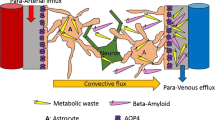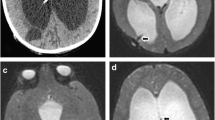Abstract
Introduction
The aim of this review is to present the contemporary role of radiology in evaluating pediatric hydrocephalus. Although conventional brain imaging with ultrasound (US), computed tomography (CT), and magnetic resonance imaging (MRI) reveal the degree of ventricular enlargement and often the etiology of the hydrocephalus, the diagnosis and management of hydrocephalus present common problems in pediatric populations.
Discussion
US, usually sufficient to assess and monitor ventricular size, is used most commonly in preterm infants who have germinal matrix hemorrhages and not able to tolerate transport to the radiology department. Although CT can demonstrate gross dilatation of ventricles, in most cases, it will be necessary to more closely define the nature of the obstruction, either functionally or anatomically. MRI is the best imaging modality to provide such functional and anatomic information. However, since identification of obstructive pathologic processes at any level through the cerebrospinal fluid (CSF) pathway in patients with hydrocephalus is of significant importance because it can change the treatment options, avoiding shunt insertion, a more sophisticated MRI approach is needed instead of obtaining a routine cranial MRI. Furthermore, the outcome after neuroendoscopic procedures is clearly related to patient selection under guidance of neuroimaging.
Conclusion
Therefore, the article focuses mainly on the effective usage of various MRI sequences in both diagnosis and follow-up of pediatric hydrocephalus, such as 3D CISS, cine PC, TSE, and GRE T2* sequences, to be able to investigate all possible obstructive pathology through the CSF pathway and to assess the efficiency of treatment in a standardized way.




























Similar content being viewed by others
References
Aleman J, Jokura H, Higano S, Akabane A, Shirane R, Yoshimoto T (2001) Value of constructive interference in steady-state three-dimensional, Fourier transformation magnetic resonance imaging for the neuroendoscopic treatment of hydrocephalus and intracranial cysts. Neurosurgery 48:1291–1295, discussion 1295–1296
Anik I, Ceylan S, Koc K, Anik Y, Etus V, Genc H (2011) Membranous structures affecting the success of endoscopic third ventriculostomy in adult aqueductus sylvii stenosis. Minim Invasive Neurosurg 54:68–74
Bartelt D, Jordan CE, Strecker EP, James AE (1975) Comparison of ventricular enlargement and radiopharmaceutical retention: a cisternographic–pneumoencephalographic comparison. Radiology 116:111–115
Dincer A, Yener U, Ozek MM (2011) Hydrocephalus in patients with neurofibromatosis type 1: MR imaging findings and the outcome of endoscopic third ventriculostomy. AJNR Am J Neuroradiol 32:643–646
Dincer A, Yildiz E, Kohan S, Memet Ozek M (2011) Analysis of endoscopic third ventriculostomy patency by MRI: value of different pulse sequences, the sequence parameters, and the imaging planes for investigation of flow void. Childs Nerv Syst 27:127–135
Dincer A, Kohan S, Ozek MM (2009) Is all “communicating” hydrocephalus really communicating? Prospective study on the value of 3D-constructive interference in steady state sequence at 3 T. AJNR Am J Neuroradiol 30:1898–1906
Doll A, Christmann D, Kehrli P, Abu Eid M, Gillis C, Bogorin A, Thiebaut A, Dietemann JL (2000) Contribution of 3D CISS MRI for pre- and post-therapeutic monitoring of obstructive hydrocephalus. J Neuroradiol 27:218–225
Drayer BP, Rosenbaum AE, Reigel DB, Bank WO, Deeb ZL (1977) Metrizamide computed tomography cisternography: pediatric applications. Radiology 124:349–357
Greitz D (2004) Radiological assessment of hydrocephalus: new theories and implications for therapy. Neurosurg Rev 27:145–165, discussion 166–147
Guillaume DJ (2010) Minimally invasive neurosurgery for cerebrospinal fluid disorders. Neurosurg Clin N Am 21:653–672, vii
James AE Jr, New PF, Heinz ER, Hodges FJ, DeLand FH (1972) A cisternographic classification of hydrocephalus. Am J Roentgenol Radium Ther Nucl Med 115:39–49
Kim DS, Choi JU, Huh R, Yun PH, Kim DI (1999) Quantitative assessment of cerebrospinal fluid hydrodynamics using a phase-contrast cine MR image in hydrocephalus. Childs Nerv Syst 15:461–467
Kurihara N, Takahashi S, Tamura H, Higano S, Furuta S, Jokura H, Umetsu A (2000) Investigation of hydrocephalus with three-dimensional constructive interference in steady state MRI. Neuroradiology 42:634–638
Laitt RD, Mallucci CL, Jaspan T, McConachie NS, Vloeberghs M, Punt J (1999) Constructive interference in steady-state 3D Fourier-transform MRI in the management of hydrocephalus and third ventriculostomy. Neuroradiology 41:117–123
Oertel JM, Mondorf Y, Schroeder HW, Gaab MR (2010) Endoscopic diagnosis and treatment of far distal obstructive hydrocephalus. Acta Neurochir (Wien) 152:229–240
Oi S, Di Rocco C (2006) Proposal of “evolution theory in cerebrospinal fluid dynamics” and minor pathway hydrocephalus in developing immature brain. Childs Nerv Syst 22:662–669
Rekate HL (2008) The definition and classification of hydrocephalus: a personal recommendation to stimulate debate. Cerebrospinal Fluid Res 5:2
Rekate HL (2009) A contemporary definition and classification of hydrocephalus. Semin Pediatr Neurol 16:9–15
Rollins N, Booth T, Shapiro K (2000) The use of gated cine phase contrast and MR venography in achondroplasia. Childs Nerv Syst 16:569–575, discussion 575–567
Stoquart-El Sankari S, Lehmann P, Gondry-Jouet C, Fichten A, Godefroy O, Meyer ME, Baledent O (2009) Phase-contrast MR imaging support for the diagnosis of aqueductal stenosis. AJNR Am J Neuroradiol 30:209–214
Tondreau RL (1985) The retrospectoscope. Egas Moniz 1874–1955. Radiographics 5:994–997
van Lindert EJ, Beems T, Grotenhuis JA (2006) The role of different imaging modalities: is MRI a conditio sine qua non for ETV? Childs Nerv Syst 22:1529–1536
Author information
Authors and Affiliations
Corresponding author
Rights and permissions
About this article
Cite this article
Dinçer, A., Özek, M.M. Radiologic evaluation of pediatric hydrocephalus. Childs Nerv Syst 27, 1543–1562 (2011). https://doi.org/10.1007/s00381-011-1559-x
Received:
Accepted:
Published:
Issue Date:
DOI: https://doi.org/10.1007/s00381-011-1559-x




